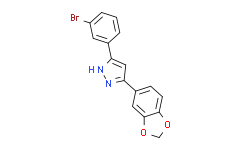| Cas No.: | 882697-00-9 |
| Chemical Name: | Anle138b |
| Synonyms: | Anle138b;Anle-138b;3-(1,3-Benzodioxol-5-yl)-5-(3-bromophenyl)-1H-pyrazole;5-(1,3-Benzodioxol-5-yl)-3-(3-bromophenyl)-1H-pyrazole;Anle 138b;CID 44608289;BCP32558;Anle138b, >=98% (HPLC);NSC805132;s6782;DB13927;3-(1,3-Benzodioxole-5-yl)-5-(3-bromophenyl)-1H-pyrazole;3-(Benzo[d][1,3]dioxol-5-yl)-5-(3-bromophenyl)-1H-pyrazole |
| SMILES: | BrC1=C([H])C([H])=C([H])C(=C1[H])C1C([H])=C(C2C([H])=C([H])C3=C(C=2[H])OC([H])([H])O3)N([H])N=1 |
| Formula: | C16H11BrN2O2 |
| M.Wt: | 343.1747 |
| Sotrage: | 2 years -20°C Powder, 2 weeks 4°C in DMSO, 6 months -80°C in DMSO |
| Description: | Anle138b is a novel oligomer modulator. |
| In Vivo: | Anle138b has no detectable toxicity at therapeutic doses and an excellent oral bioavailability and blood–brain-barrier penetration. In mouse models of prion disease and in three different PD mouse models, anle138b strongly inhibits oligomer accumulation, neuronal degeneration, and disease progression[1]. Di-phenyl-pyrazole anle138b binds to aggregated tau and inhibits tau aggregation. Anle138b treatment effectively ameliorates disease symptoms, increases survival time and improves cognition of tau transgenic PS19 mice[2]. |
| In Vitro: | Oligomeric aggregates are presumed to be the key neurotoxic agent. Anle138b blocksthe formation of pathological aggregates of prion protein and of α-synuclein, which is deposited in Parkinson’s disease and other synucleinopathies such as dementia with Lewy bodies and multiple system atrophy. Anle138b strongly inhibits all prion strains tested including BSE-derived and human prions. Anle138b shows structure-dependent binding to pathological aggregates and strongly inhibits formation of pathological oligomers both for prion protein and α-synuclein[1]. |






















